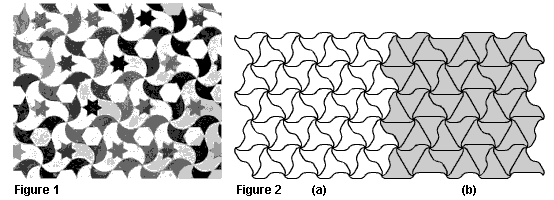page 1
Spiral Tilings with S-curves and C-curves
Using Combinatorics to Augment Tradition
Chris K. Palmer
7513 Kelsey’s Lane, Rosedale MD, 21237
chris@shadowfolds.com ~ www.shadowfolds.com
Abstract
Spiral tilings used by artisans through the ages using S-curves, C-curves and combinations of S-curves and C-curves are identified. The complete combinatoric set of these tiles is determined and tilings that can be made with them are examined.

Throughout the history of ornament artisans from many cultures have composed patterns utilizing spirals. Many of the compositions made by these artisans can be understood as the substitutions of C-curves or S-curves or a combination of C-curves and S-curves for the straight lines of a monohedral or polyhedral tiling [1]. Those known and used by traditional craftsmen are shown below in Figures 2a and Figure 3[2]. Artisans can apply and have applied an enormous variety of styles using these tilings. An example of this variety can be seen in the ceramic mosaic from the Alhambra shown in Figure 1 and the simpler style of the same pattern in Figure 2a. Another example of this variety can be seen by observing the expression of the same tiling, (4.4.4.4), in two different styles, a simple form in Figure 3a and 3b and a Celtic style in Figure 4a and 4b. These underlying tilings are part of a set of tilings with regular vertices commonly known as Laves tilings[3]. This paper identifies the complete set of tiles (shown in Figure 5a-b) and gives some example of the tilings that can be made with them. This greatly augments the number of underlying tilings available for use by artisans from those shown in Figure 2a and Figure 3 to an infinite number of tilings [4].

